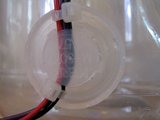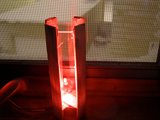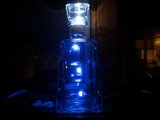You are hereHome / Arduino Projects / Project Page: Old Hancock
Project Page: Old Hancock
The Old Hancock
In Boston it’s not uncommon to hear one of the locals say “It’s flashing blue at the Hancock.” Translated that statement means it’s cloudy. “Old Hancock” refers to the older of the two Hancock buildings in Copley square. The newer one was built by I.M. Pei and has the dubious distinction of having had windows fall off it from really high up.
The Old Hancock building is adorned with a weather beacon illuminated with either a red or blue light that is either steady or flashing. Current weather conditions are signaled by the state of the light:
Steady blue, clear view
Flashing blue, clouds are due
Steady red, rain ahead
Flashing red, snow instead
In the summer flashing red signals that the Red Sox game has been postponed.
 I had the idea to make a model of the weather beacon using an Arduino fitted with an Ethernet shield and a tri-color LED. This idea came to fruition when I realized that an empty plastic tequila bottle I had would make a smashing prototype for the model.
I had the idea to make a model of the weather beacon using an Arduino fitted with an Ethernet shield and a tri-color LED. This idea came to fruition when I realized that an empty plastic tequila bottle I had would make a smashing prototype for the model.
Software
Weather information is obtained from the web site www.weather.gov, which publishes current conditions in XML format. Code running on the Arduino parses the information and lights the LEDs appropriately.
I had to check the feed in different weather conditions to learn how they were listed. Fortunately, in New England it does not take long to experience many weather conditions. I discovered that the only term used for sunny weather with no precipitation is “fair”, so fair = steady blue. If it is not fair then I check whether the conditions include “rain”, “drizzle” or “shower” to indicate steady red or “snow” to indicate flashing red. If none of the above conditions are met then flashing blue is called for. To indicate a Red Sox postponement there is a flag in the code that must be set manually.
Prototype
 The prototype build was not very complicated. I drilled a hole in the top of the bottle for the LED and ran the three wires from the 5V (common anode) , red and blue legs down the side of the bottle. Resistors soldered to the wires from the red and blue legs plug directly into two digital output pins of the Arduino. The one inspired moment came when I realized that the pourer built into the top of the bottle would be really good for organizing the wires and glued it to the side of the bottle near the base.
The prototype build was not very complicated. I drilled a hole in the top of the bottle for the LED and ran the three wires from the 5V (common anode) , red and blue legs down the side of the bottle. Resistors soldered to the wires from the red and blue legs plug directly into two digital output pins of the Arduino. The one inspired moment came when I realized that the pourer built into the top of the bottle would be really good for organizing the wires and glued it to the side of the bottle near the base.
Final Build
For the next iteration of the model I used Hobby “don’t call me popsicle” Sticks and hand-cut glass. The glass was from a 12” square of picture frame glass left over from another project. It was the first time that I ever cut glass and it proved to be a study in frustration. After several broken pieces I was able to make the four good cuts that I needed.
 I cut the rounded ends off the sticks with a Dremel. The base is made of four pieces, about a third of the length of the sticks, glued together in a cross shape with a hole drilled in the center for the LED. Upright sticks are glued to the end of each of the base sticks.
I cut the rounded ends off the sticks with a Dremel. The base is made of four pieces, about a third of the length of the sticks, glued together in a cross shape with a hole drilled in the center for the LED. Upright sticks are glued to the end of each of the base sticks.
The tricky part was fitting the glass pieces between the upright sticks. I thought that double sided tape on the length of the uprights might be enough to keep the glass in place. It wasn't’t quite good enough, though, so I had to use glue at the top and bottom of each pane.  The double sided tape did prove to be good at reflecting the light from the LED. So far there has been no Peiesque falling glass.
The double sided tape did prove to be good at reflecting the light from the LED. So far there has been no Peiesque falling glass.
In the end it turned out to be more of an “abstract interpretation” than a “model” of the Old Hancock weather beacon, like Brancusi’s “Bird in Space” is an abstract interpretation of a bird.
 The latest incarnation of the Old Hancock goes back to its tequila bottle roots. The shape of the Jose Cuervo 1800 bottle, with it's hollow cap that doubles as a shot glass, gives it a nice look for this project. The real building has a constant white light on the top, so this bottle has a white LED inside the top. I had to drill a hole through the bottom of the bottle, the special Dremmel glass drilling bit made it relatively easy.
The latest incarnation of the Old Hancock goes back to its tequila bottle roots. The shape of the Jose Cuervo 1800 bottle, with it's hollow cap that doubles as a shot glass, gives it a nice look for this project. The real building has a constant white light on the top, so this bottle has a white LED inside the top. I had to drill a hole through the bottom of the bottle, the special Dremmel glass drilling bit made it relatively easy.
